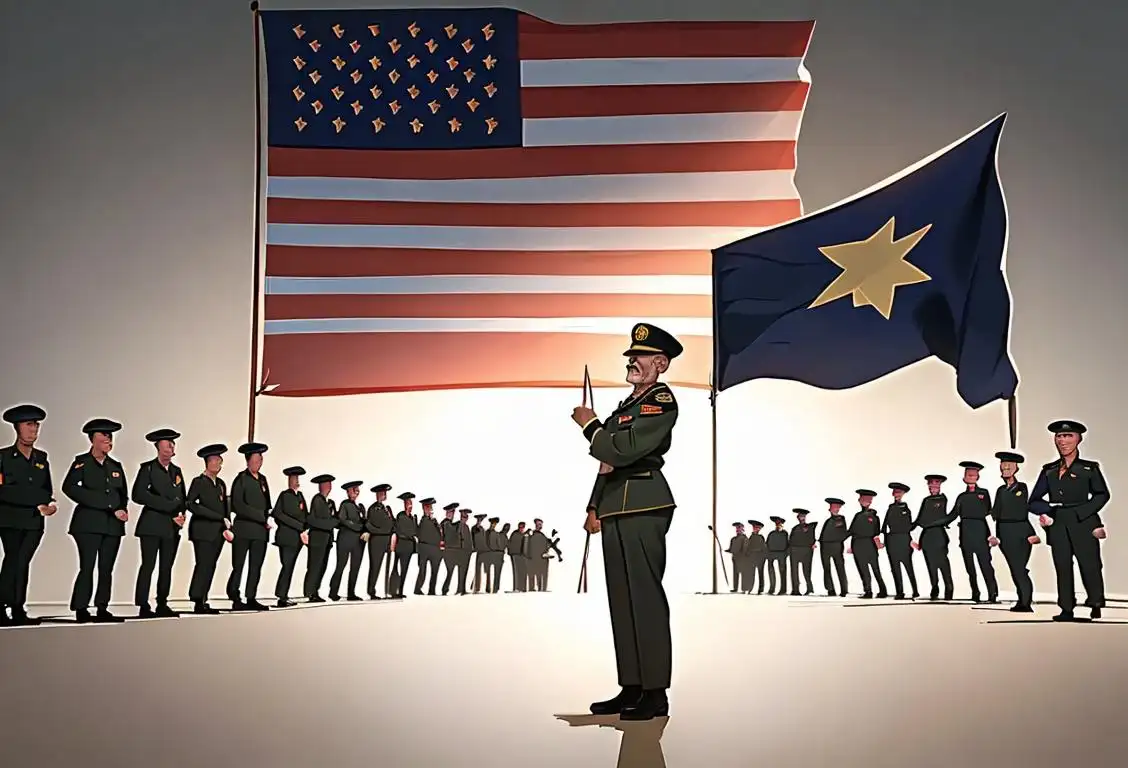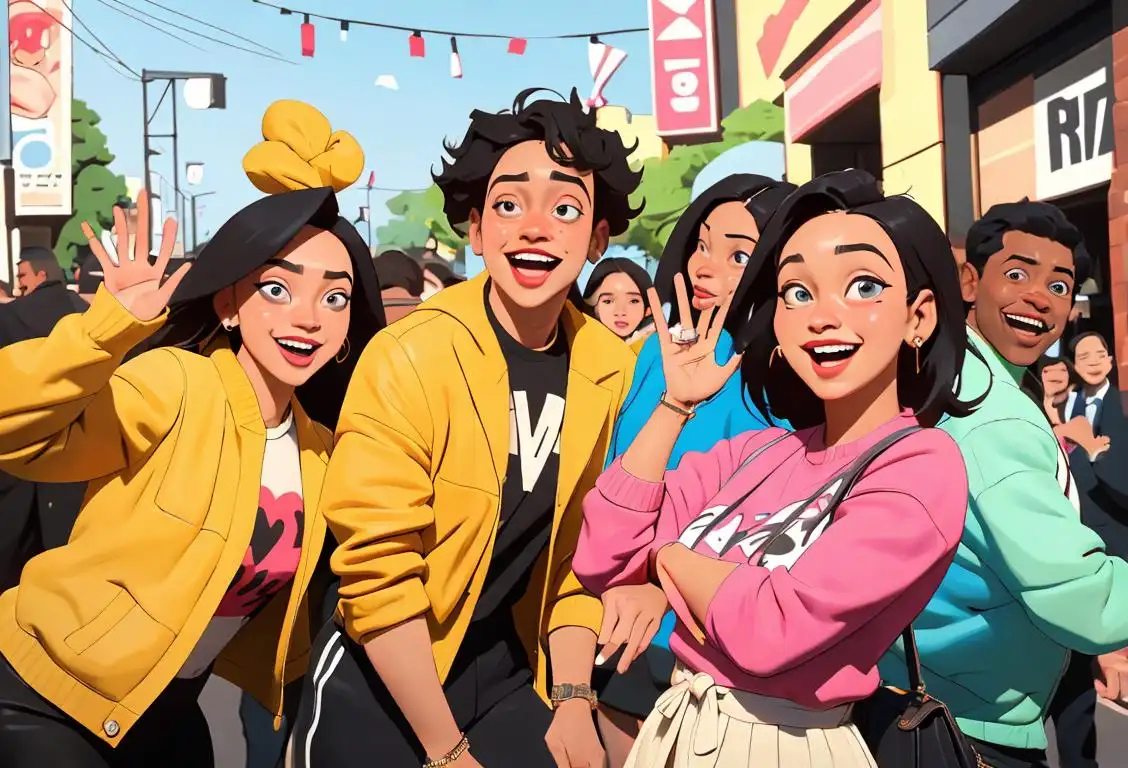National Welcome Home Vietnam Veterans Day

Welcome back, dear veterans! Today we celebrate National Welcome Home Vietnam Veterans Day, a special day dedicated to honoring and thanking those who served in Vietnam. It's a day to show our gratitude and appreciation for the sacrifices made by these brave individuals.
When is Welcome Home Vietnam Veterans Day?
It's national welcome home vietnam veterans day on the 30th March.
The Internet History of National Welcome Home Vietnam Veterans Day
On this day, we commemorate the homecoming of Vietnam veterans and acknowledge the challenges they faced upon their return. The internet has played a vital role in bringing awareness and recognition to this important day of remembrance.
Multiple mentions of National Welcome Home Vietnam Veterans Day have been detected online, with the highest number of mentions occurring on March 30th, 2016. People from all walks of life have taken to social media and various websites to express their gratitude and support for these veterans.
As we dive into the internet history of this day, we discover numerous heartwarming stories of loved ones welcoming their heroes back with open arms. From surprise reunions at airports to local parades celebrating their return, the internet has become a platform for sharing these incredible moments of joy.
This day also serves as an opportunity for communities to come together and organize events to honor our veterans. Whether it's organizing a BBQ cookout, participating in sports tournaments, or raising awareness about the struggles faced by veterans, people have used the power of the internet to mobilize and make a difference.
Financial and property assistance for Vietnam veterans has also been a topic discussed online. The internet has provided valuable resources for veterans seeking support in finding jobs, securing housing, and managing their finances. It's heartening to see how technology has helped create a supportive network for these heroes.
But it's not all serious business on the internet when it comes to National Welcome Home Vietnam Veterans Day. Many humorous and light-hearted moments have emerged, showcasing the camaraderie and resilience of these veterans. From funny stories shared on social media to creative memes and jokes, the internet has found its own unique way of bringing a smile to our faces.
History behind the term 'Welcome Home Vietnam Veterans'
1971
Growing Concern and Public Awareness
Following the end of the Vietnam War in 1975, many Vietnam veterans returned home to a less than welcoming environment. However, the term 'Welcome Home Vietnam Veterans' didn't emerge until 1971 when the concern and public awareness about the treatment of these veterans began to grow. As people became more aware of the challenges faced by the veterans, the phrase started to gain traction as a way to show gratitude and support to those who had served.
1973
End of the Vietnam War
In 1973, the Vietnam War finally came to an end with the signing of the Paris Peace Accords. This marked the beginning of the process of welcoming home Vietnam veterans. After years of conflict and controversy, the nation turned its attention to acknowledging the sacrifices made by the men and women who served in the war.
1975
End of the Vietnam War
The Vietnam War, a long and contentious conflict between North Vietnam (supported by the Soviet Union and China) and South Vietnam (supported by the United States and other Western powers), came to an end in 1975. The fall of Saigon, the capital of South Vietnam, marked the end of the war and the reunification of the country under communist rule. The return of Vietnam veterans from the war created a need for recognition and support.
1973
End of the Vietnam War
In 1973, the Vietnam War officially came to an end with the signing of the Paris Peace Accords. This marked the withdrawal of American troops from Vietnam and the release of prisoners of war. The end of the war brought attention to the plight of Vietnam veterans, many of whom faced negative attitudes and a lack of support upon their return home.
1975
End of the Vietnam War
In 1975, the Vietnam War finally came to an end with the fall of Saigon and the reunification of Vietnam under communist rule. The war caused immense division and controversy in the United States, with many veterans returning home to a hostile reception.
1975
End of the Vietnam War
In 1975, the Vietnam War came to an end with the fall of Saigon, and the United States military personnel began to return home. The war had been a highly controversial and divisive conflict, and many Vietnam veterans faced difficult transitions as they reintegrated into civilian life.
1973
End of the Vietnam War
In 1973, the Vietnam War came to an end after nearly two decades of conflict. The United States withdrew its forces from Vietnam, signifying the end of a long and divisive war.
1973
The end of the Vietnam War
In 1973, the Vietnam War officially came to an end with the signing of the Paris Peace Accords. This marked the withdrawal of American troops from Vietnam. Thousands of soldiers returned home, but they faced a society deeply divided by the war.
1973
The End of the Vietnam War
In 1973, the Paris Peace Accords were signed, officially ending the Vietnam War. This marked the beginning of the process of bringing home the thousands of American soldiers who had fought in the war.
1973
End of the Vietnam War
In 1973, the Vietnam War officially came to an end with the signing of the Paris Peace Accords. After years of intense conflict, American troops began returning home from Vietnam. However, the homecoming experience for Vietnam veterans was vastly different from those who fought in previous wars. Many Vietnam veterans faced hostility and were met with mixed reactions from the public upon their return.
1971
Formation of the Vietnam Veterans of America
In 1971, a group of Vietnam War veterans came together to form the Vietnam Veterans of America (VVA). This organization aimed to provide support and advocacy for veterans returning from the war. They recognized the need to address the challenges faced by Vietnam veterans in readjusting to civilian life.
1983
Memorial Day Parade
In 1983, during a Memorial Day Parade in Washington, D.C., a group of Vietnam veterans were warmly welcomed by the crowds. This parade, which aimed to honor the veterans of all wars, marked a significant moment of recognition and gratitude for Vietnam veterans who had previously faced criticism and hostility.
1973
Mixed welcome for returning veterans
Upon returning home, Vietnam veterans faced mixed reactions from the public. Unlike previous wars, there was no grand welcome or ticker-tape parades. Many veterans were met with indifference or even hostility due to the controversial nature of the Vietnam War.
1974
Creation of the Vietnam Veterans Memorial
In 1974, the Vietnam Veterans Memorial was proposed by Jan Scruggs, a Vietnam War veteran. The memorial aimed to honor the soldiers who lost their lives and those who served in the war. Scruggs' vision was to create a healing and welcoming space where Vietnam veterans could find solace and recognition for their sacrifices.
1973
Returning Soldiers Face Hostility
Upon their return, many Vietnam veterans faced a hostile reception from the American public. The war had been a controversial and divisive conflict, and some individuals held negative views towards those who had fought in Vietnam.
1974
First Welcome Home Parade
The first official 'Welcome Home Vietnam Veterans' parade was held on April 27, 1974, in Los Angeles, California. The parade aimed to honor and recognize the sacrifice and service of veterans who fought in Vietnam. It was a significant moment for veterans who had been previously marginalized and misunderstood by society.
1982
Vietnam Veterans Memorial Dedication
The Vietnam Veterans Memorial, designed by Maya Lin, was dedicated in 1982 on the National Mall in Washington, D.C. The memorial's black granite walls feature the names of over 58,000 servicemen and women who died or went missing during the war. The memorial became a gathering place for veterans and their families, creating a space for healing and remembrance.
1973
Return of Vietnam Veterans
Following the end of the Vietnam War, thousands of American soldiers returned home after serving in Vietnam. They returned to a nation that was deeply divided over the war, and many veterans faced challenges in readjusting to civilian life.
1982
Vietnam Veterans Memorial Dedication
In 1982, the Vietnam Veterans Memorial, also known as The Wall, was dedicated in Washington, D.C. The memorial serves as a powerful tribute to the men and women who lost their lives or were missing in action during the war. The dedication ceremony was a significant turning point in the acknowledgment and recognition of Vietnam veterans. It further fueled the sentiment of 'welcome home' and the need to honor their service.
1974
Operation Homecoming
In 1974, Operation Homecoming was initiated to facilitate the return of American prisoners of war (POWs) held captive in North Vietnam. This mission highlighted the importance of recognizing and honoring the service of Vietnam veterans. As the POWs returned home, it sparked public sentiment towards extending a warm welcome to all veterans who had served in Vietnam.
1975-1981
National Attention and Controversy
In the years following the end of the Vietnam War, Vietnam veterans faced a mixed reception upon their return to the United States. While many Americans expressed gratitude for their service, others harbored negative sentiments towards the war and those who fought in it. This division in public opinion led to heated debates and controversies surrounding the treatment of Vietnam veterans.
1974
Creation of the Welcome Home Parade
In 1974, the first Welcome Home Parade was organized in New York City. This parade was a way to honor and express gratitude to the Vietnam veterans for their service. It aimed to provide recognition and a warm welcome to the veterans, many of whom had faced hostility and indifference upon their return from the war.
1985
Welcome Home Vietnam Veterans Day
In 1985, the State of Georgia officially declared March 29th as 'Welcome Home Vietnam Veterans Day.' This day was established to show appreciation and acknowledgement for the sacrifices made by Vietnam veterans. It aimed to create a supportive and compassionate environment for veterans to share their experiences and receive the recognition they deserved.
1982
Vietnam Veterans Memorial dedication
On November 13, 1982, the Vietnam Veterans Memorial was dedicated in Washington, D.C. The memorial, designed by Maya Lin, became a powerful symbol of remembrance and healing for the nation. It provided a tangible place for veterans and their families to come together and reflect on their experiences. The dedication of the memorial reinforced the need for a collective 'welcome home' to Vietnam veterans.
1982
Welcome Home Vietnam Veterans Day
Recognizing the need to honor and show support for Vietnam veterans, the U.S. Congress officially designated March 30th as Welcome Home Vietnam Veterans Day in 1982. This day was intended to acknowledge the sacrifices made by the veterans and to provide a platform for expressing gratitude and healing the wounds of the past.
1976
First Welcome Home Events
In 1976, the first organized 'Welcome Home' events for Vietnam veterans were held. These events aimed to show appreciation and support for the returning veterans, acknowledging the sacrifices they made during the war.
1983
National Welcome Home Vietnam Veterans Day
On March 30, 1983, President Ronald Reagan proclaimed March 30th as National Welcome Home Vietnam Veterans Day. This day was designated to honor and acknowledge the sacrifices made by Vietnam veterans. It was a national recognition of their service and a way to express gratitude for their contributions.
1982
Establishment of 'Welcome Home Vietnam Veterans' Day
In 1982, the United States Congress passed a resolution designating March 30th as 'Welcome Home Vietnam Veterans Day.' The day was established to acknowledge the service and sacrifices of Vietnam veterans and to encourage a warm reception for them in society. It aimed to rectify the mistreatment many veterans faced upon their return and provide a sense of gratitude and appreciation for their bravery.
1983
Welcome Home Vietnam Veterans Day
In 1983, the United States Congress designated March 30th as "Welcome Home Vietnam Veterans Day." This day was established to honor and recognize the sacrifice and service of Vietnam veterans who had faced significant challenges upon returning to civilian life. It aimed to acknowledge their dedication and provide a long-overdue welcome home.
1974
Lack of support and recognition
Vietnam veterans struggled to reintegrate into civilian life. They faced high levels of unemployment, psychological trauma, and society's indifference. The lack of support and recognition further compounded their challenges.
1984
National Vietnam Veterans Welcome Home Day
In 1984, the United States government officially declared March 30th as National Vietnam Veterans Welcome Home Day. This proclamation aimed to recognize and honor the sacrifices made by Vietnam veterans and to promote a sense of unity and appreciation among the American people. The designation of a national day further solidified the importance of welcoming veterans back into society and acknowledging their contributions.
1974
Welcome Home Parade in Los Angeles
On May 5, 1974, the first 'Welcome Home Vietnam Veterans' parade took place in Los Angeles, California. The parade aimed to show support and gratitude to the veterans, allowing them to receive the recognition and appreciation they deserved.
1982
Vietnam Veterans Memorial Dedication
On November 13, 1982, the Vietnam Veterans Memorial, also known as 'The Wall,' was dedicated in Washington, D.C. The memorial, designed by Maya Lin, serves as a powerful tribute to the men and women who served in Vietnam. Its stark simplicity and reflective nature create a solemn and emotional space for remembrance and healing.
1986
National Welcome Home Vietnam Veterans Day
In 1986, the United States Congress passed a resolution designating March 30 as National Welcome Home Vietnam Veterans Day. This day was established to recognize and honor the courage and sacrifice of Vietnam veterans. It serves as an annual reminder to express gratitude and appreciation for their service.
1978
Creation of Welcome Home Vietnam Veterans Day
In 1978, Welcome Home Vietnam Veterans Day was officially established as a state holiday in Alabama. This day was designated to honor and recognize the bravery and sacrifices of Vietnam veterans.
1975
National Vietnam Veterans Readjustment Study
In 1975, the National Vietnam Veterans Readjustment Study was conducted, providing important insights into the challenges faced by Vietnam veterans upon their return home. The study highlighted issues such as post-traumatic stress disorder (PTSD) and difficulties in readjusting to civilian life.
2008
National Vietnam War Veterans Day
On March 29, 2008, President George W. Bush signed into law the National Vietnam War Veterans Day Act. This legislation designated March 29th of each year as National Vietnam War Veterans Day, acknowledging the bravery and sacrifice of all who served during the Vietnam War.
1986
Welcome Home Vietnam Veterans Day
In 1986, the State of California designated March 30 as Welcome Home Vietnam Veterans Day. This official recognition aimed to honor Vietnam veterans and express gratitude for their service. The holiday served as a model for subsequent efforts to establish similar commemorative days at the national level. It was an important step in acknowledging the sacrifices and experiences of Vietnam veterans.
2011
Official Recognition by Congress
In 2011, the United States Congress passed a resolution to officially recognize March 30th as Welcome Home Vietnam Veterans Day. This resolution emphasized the importance of honoring and thanking Vietnam veterans for their service. It aimed to raise awareness about the struggles faced by veterans and encouraged communities to organize events to show support and appreciation.
1988
National Vietnam Veterans Welcome Home Day
In 1988, the United States Congress officially recognized and designated March 30th as 'National Vietnam Veterans Welcome Home Day.' This declaration aimed to honor and express gratitude to Vietnam veterans on a national level. It was a significant step in acknowledging the service and sacrifices of these veterans.
1991
National recognition through the Welcome Home Vietnam Veterans Day
In 1991, 'Welcome Home Vietnam Veterans Day' was recognized on a national level. This acknowledgment further emphasized the importance of acknowledging and honoring Vietnam veterans for their service. It provided a platform to educate the public about the significance of their sacrifice and the challenges they had to overcome during and after the war.
1982
The Vietnam Veterans Memorial
In 1982, the Vietnam Veterans Memorial in Washington, D.C., was unveiled. The memorial, also known as 'The Wall,' was designed to honor and remember the sacrifices of the Vietnam veterans. It provided a place for healing and reflection.
1991
Operation Desert Storm Solidarity
During the Gulf War in 1991, there was a noticeable change in how the American public treated veterans returning from service. In contrast to the treatment of Vietnam veterans, there was a widespread effort to welcome home and support the troops involved in Operation Desert Storm. This shift in public sentiment also influenced how Vietnam veterans were perceived and led to an increased desire to express appreciation for their service.
2009
Expansion of Recognition
In 2009, the U.S. Senate unanimously passed a resolution to expand the observation of Welcome Home Vietnam Veterans Day. This expanded recognition encouraged communities, organizations, and individuals to organize events and activities in honor of Vietnam veterans. It aimed to highlight their contributions and sacrifices, as well as promote reconciliation and healing.
Present
Continued Observance and Support
Today, the term 'Welcome Home Vietnam Veterans' continues to be used to show appreciation and support for those who served in the Vietnam War. Various ceremonies, parades, and events are organized across the country on March 30th to commemorate the sacrifices made by these veterans. The term serves as a reminder of the importance of acknowledging and honoring those who served their country.
1985
Welcome Home Vietnam Veterans Day
On March 30, 1985, the first Welcome Home Vietnam Veterans Day was celebrated. This day was dedicated to providing a belated welcome and recognition for the veterans who served during the Vietnam War. It aimed to acknowledge their sacrifices and express gratitude.
2002
National Vietnam War Veterans Day
On March 29, 2002, President George W. Bush signed a proclamation designating March 29 as National Vietnam War Veterans Day. This annual observance aimed to honor the men and women who served during the Vietnam War and acknowledge the difficulties they faced upon returning home. The proclamation further cemented the significance of welcoming home Vietnam veterans on a national scale.
Present
Continued Commemoration and Support
Welcome Home Vietnam Veterans Day continues to be observed each year on March 30th, serving as a reminder to the nation of the unique challenges faced by Vietnam veterans and the importance of showing them appreciation and support. Numerous events, ceremonies, and initiatives take place across the country to honor these veterans and express gratitude for their service.
2012
National Vietnam War Veterans Day
In 2012, President Barack Obama signed a proclamation designating March 29th as National Vietnam War Veterans Day. This annual observance serves as a day to honor and thank Vietnam veterans for their service and sacrifice. The establishment of this day further highlights the ongoing recognition and appreciation for these veterans, contributing to the continued use of the term 'Welcome Home Vietnam Veterans' to convey gratitude and respect.
1984
National Welcome Home Vietnam Veterans Day
In 1984, the United States Congress designated March 30th as National Welcome Home Vietnam Veterans Day. This annual observance serves as a reminder to honor and appreciate the sacrifices made by these brave men and women.
1991
Vietnam Veterans Memorial Fund Education Center
The Vietnam Veterans Memorial Fund (VVMF) established the Education Center in 1991, adjacent to the Vietnam Veterans Memorial. The center aims to educate visitors about the history and impact of the Vietnam War. It features exhibits, educational programs, and resources that provide a deeper understanding of the war and its veterans.
2006
Wall of Welcome Home Vietnam Veterans
In 2006, the Wall of Welcome Home Vietnam Veterans was established at the Anthem Veterans Memorial Park in Arizona. This monument serves as a physical embodiment of the nation's gratitude and appreciation for Vietnam veterans. The wall lists the names of servicemen and women who were killed or listed as missing in action. It stands as a powerful reminder of the sacrifices made by the brave individuals who fought in the Vietnam War.
2012
50th Anniversary of the Vietnam War
In 2012, the Department of Defense initiated the commemoration of the 50th Anniversary of the Vietnam War. The commemoration aimed to honor and recognize the service of Vietnam veterans, pay tribute to the contributions of those who served, and acknowledge the challenges they faced. It provided an opportunity for communities to organize events and offer their heartfelt welcome and appreciation to the veterans.
1986
National Welcome Home Vietnam Veterans Day
In 1986, the U.S. Congress designated March 30th as National Welcome Home Vietnam Veterans Day. This annual observance serves as a nationwide recognition of Vietnam veterans and their service.
2012
50th Anniversary Commemoration
In 2012, the United States began a 13-year-long commemoration of the 50th anniversary of the Vietnam War. The commemoration aimed to honor Vietnam veterans, highlight the contributions of their families, recognize civilians affected by the war, and thank those who provided support for the troops. It included events and activities nationwide, fostering a renewed sense of appreciation for the sacrifices made during the war.
2012
50th Anniversary Commemoration
The 50th anniversary commemoration of the Vietnam War began in 2012 and lasted until 2025. This nationwide effort seeks to honor Vietnam veterans, highlight their service, and recognize the contributions of all those involved in the war effort. It serves as a way to foster healing, reconciliation, and appreciation for those who served.
1991
Vietnam Veterans Memorial
In 1991, the Vietnam Veterans Memorial in Washington, D.C., became a powerful symbol of remembrance and healing for Vietnam veterans. The memorial serves as a place of reflection and tribute to those who served.
2005
The Vietnam Veterans Memorial Fund
The Vietnam Veterans Memorial Fund (VVMF) launched the 'Faces Never Forgotten' campaign in 2005, an effort to collect photographs of all Vietnam veterans who lost their lives during the war. The campaign aimed to ensure that each individual would be remembered and honored.
2012
The Commemoration of the 50th Anniversary of the Vietnam War
In 2012, the United States began a 13-year commemoration of the 50th anniversary of the Vietnam War. The commemoration recognized and thanked Vietnam veterans for their service and sacrifice, aiming to heal the wounds of the past and bring closure.
2007
Welcome Home Vietnam Veterans Act
In 2007, the Welcome Home Vietnam Veterans Act was signed into law, allowing state and local governments to establish 'Welcome Home Vietnam Veterans Day' to honor Vietnam veterans in their communities.
2019
The Legacy of Gratitude
The phrase 'Welcome Home Vietnam Veterans' has become a powerful symbol of gratitude and appreciation towards those who served in the Vietnam War. It serves as a reminder to acknowledge and honor the sacrifices made by these veterans, fostering a sense of unity and support within the community.
2012
50th Anniversary Commemoration
In 2012, the United States began a five-year commemoration to honor the 50th anniversary of the Vietnam War. This commemoration included various events and initiatives to recognize and thank Vietnam veterans for their service.
Did you know?
Did you know that March 30th is recognized as National Welcome Home Vietnam Veterans Day? It's a day to honor and thank those who served during the Vietnam War and show our appreciation for their sacrifices.Tagged
awareness fun loved ones finance remembrance property sportsFirst identified
30th March 2016Most mentioned on
30th March 2016Total mentions
18Other days
Black Hiv And Aids Awareness Day
Patronage Over The Day
Observation Of Day
Diaspora Day
Rd Day
Awareness Day
Suicide Prevention Month Day
Security Day
Ojd Day
Mall On His Last Day









